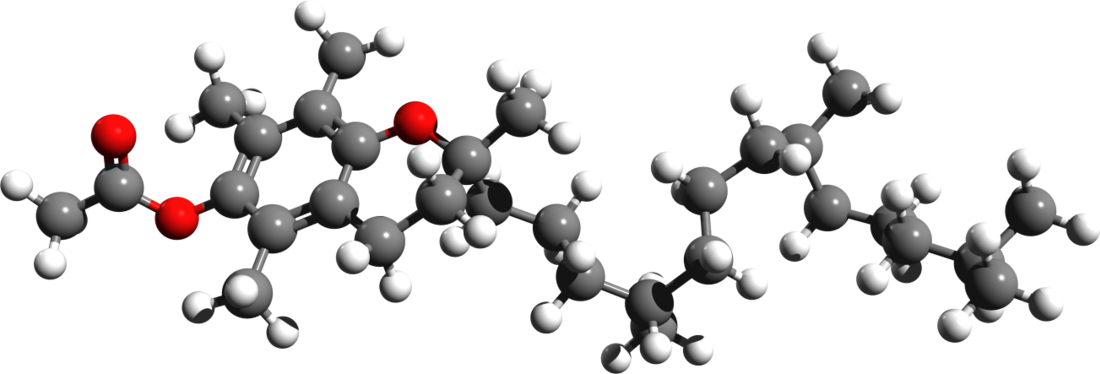Top Qs
Timeline
Chat
Perspective
Α-Tocopheryl acetate
Vitamin From Wikipedia, the free encyclopedia
Remove ads
α-Tocopheryl acetate (alpha-tocopherol acetate), also known as vitamin E acetate, is a form of vitamin E with D-Alpha Tocopheryl Acetate as the natural form and DL-Alpha Tocopheryl Acetate as the synthetic form. DL-indicates the synthetic form where as D- indicates the natural form. It is the ester of acetic acid and α-tocopherol.[2]
The U.S. Centers for Disease Control and Prevention says that vitamin E acetate is a very strong culprit of concern in the 2019 outbreak of vaping-associated pulmonary injury (VAPI),[3] but there is not yet sufficient evidence to rule out contributions from other chemicals.[4][5] Vaporization of this ester produces toxic pyrolysis products.[6]
Remove ads
Use in cosmetics
α-Tocopheryl acetate is often used in dermatological products such as skin creams. It is not oxidized and can penetrate through the skin to the living cells, where about 5% is converted to free tocopherol. Claims are made for beneficial antioxidant effects.[7] α-Tocopheryl acetate is used as an alternative to tocopherol itself because the phenolic hydroxyl group is blocked, providing a less acidic product with a longer shelf life. It is believed that the acetate is slowly hydrolyzed after it is absorbed into the skin, regenerating tocopherol and providing protection against the sun's ultraviolet rays.[8] Tocopheryl acetate was first synthesized in 1963 by workers at Hoffmann-La Roche.[9]
Although there is widespread use of tocopheryl acetate as a topical medication, with claims for improved wound healing and reduced scar tissue,[10] reviews have repeatedly concluded that there is insufficient evidence to support these claims.[11][12] There are reports of vitamin E-induced allergic contact dermatitis from use of vitamin E derivatives such as tocopheryl linoleate and tocopherol acetate in skin care products. Incidence is low despite widespread use.[13]
Remove ads
Misuse
Summarize
Perspective
Ingredient in vape liquids
On September 5, 2019, the United States Food and Drug Administration (US FDA) announced that 10 out of 18, or 56% of the samples of vape liquids sent in by states, linked to the then recent vaping-related lung disease outbreak in the United States, tested positive for vitamin E acetate[14] which had been used as a thickening agent by illicit THC vape cartridge manufacturers.[15] On November 8, 2019, the Centers for Disease Control and Prevention (CDC) identified vitamin E acetate as a very strong culprit of concern in the vaping-related illnesses, but has not ruled out other chemicals or toxicants as possible causes.[3] The CDC's findings were based on fluid samples from the lungs of 29 patients with vaping-associated pulmonary injury, which provided direct evidence of vitamin E acetate at the primary site of injury in all the 29 lung fluid samples tested.[3] Research suggests when vitamin E acetate is inhaled, it may interfere with normal lung functioning.[5] A 2020 study found that vaporizing vitamin E acetate produced carcinogenic alkenes and benzene, but also exceptionally toxic ketene gas, which may be a contributing factor to the pulmonary injuries.[6]
Remove ads
Chemistry
At room temperature, α-tocopheryl acetate is a fat-soluble liquid. It has 3 chiral centers and thus 8 stereoisomers. It is made by esterifying α-tocopherol with acetic acid. 2R,4R,8R-isomer, also known as RRR-α-tocopheryl acetate, is the most common isomer used for various purposes. This is because α-tocopherol occurs in nature primarily as RRR-α-tocopherol.[2]
α-Tocopherol acetate does not boil at atmospheric pressure and begins to degrade at 240 °C.[2] It can be vacuum distilled: it boils at 184 °C at 0.01 mmHg, at 194 °C (0.025 mmHg) and at 224 °C (0.3 mmHg). In practice, it is not degraded notably by air, visible light or UV-radiation. It has a refractive index of 1.4950–1.4972 at 20 °C.[1]
α-Tocopherol acetate is hydrolyzed to α-tocopherol and acetic acid under suitable conditions or when ingested by people.[2]
References
Wikiwand - on
Seamless Wikipedia browsing. On steroids.
Remove ads



